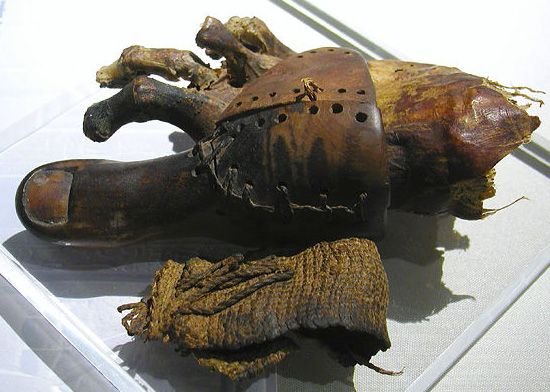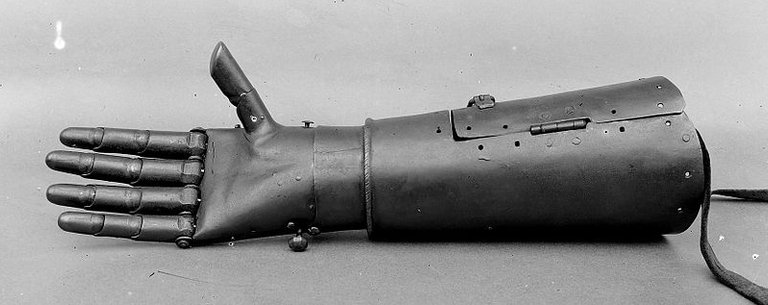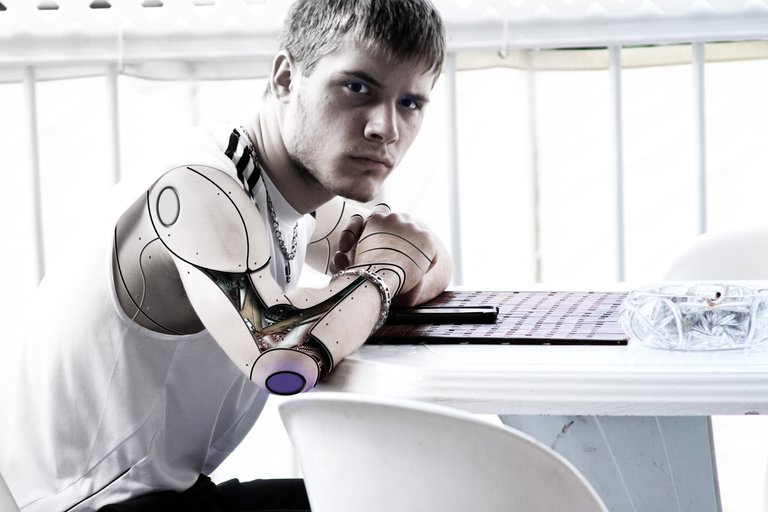In the area of medicine prosthesis have brought hope to amputees by allowing them to still go about their normal business even after the loss of a certain part of their body.
These materials are sometimes beautifully crafted to look almost exactly like the missing part, and if one does not take a careful look you can easily be fooled into thinking it's the real thing. Personally I know some people who use prosthesis and they will tell you that once you master how to use it, it almost feels like the real thing - but not fully.
Prosthesis have gone through numerous innovation over the years to the point where we now have those that can move. This innovation reminds me of a scene from the famous star wars movie where a character named Luke Skywalker who lost his limb and in the end was given one that works exactly the real thing. Although science is yet to advance to that point like starwars but scientist have been able to make significant breakthrough by inventing a prosthetic that can be controlled by a smart phone.
In this article I will be looking at prosthesis and will share some light on one of the latest innovation in the development of prosthesis.
What is prosthesis
Prosthesis or prosthetic limbs is an artificial limb made to substitute limbs lost either by accident, trauma, illness or any other medical condition that might lead to amputation.
Prosthetic limbs can allow people using it to walk, run, swim drive and carry out some of their daily activities. It is even thought that some prosthetic limbs gives disabled athletes an advantage over able-bodied athletes. A case in point was the south African sprinter Oscar Pistorius, who was stopped by the IAAF from competing with able-bodied athletes.
There is another type of prosthesis known as cosmesis, which is specially designed for cosmetic purposes. It's beautifully crafted in such a way that it looks very similar to a real limb.
How did it come about? A short history of Prosthesis
Image credit : wikipedia creative commons - Prosthetic toe from ancient Egypt. link

The earliest known prosthesis found is Toe and can be traced back to the Egyptian empire. The Toe was said to have belonged to a noble woman and it dates back between 950 - 710 BCE. The toe was particularly important back then because it allowed her to wear the traditional Egyptian sandals.
A famous Roman soldier known as General Marcus Sergus was documented as the first to wear a prosthetic limb, he lost his limb during the second Punic war. After he lost his limb he was given prosthesis made out of Iron that enabled him hold his shield which allowed him to fight.
In the early sixteenth century a Doctor known as Ambroise Pare was the first to introduce a hinged prosthetic hand and a leg with a locking knee joint. His innovative ideas inspired doctors to shape limbs which were more acceptable to the attachment of prosthesis and it made it comfortable for those wearing them.
In the 1970s an inventor known Ysidro Martinez developed a lower limb prosthesis that focused on improving gait and reducing friction instead of replicating the motion of a natural limb. This made a huge impact because it made walking more comfortable thereby improving the lives of many patients.
Types of prosthesis
There are four types of prosthesis with each corresponding to the removal of the hand or leg.
1. Below the knee (transtibial) prosthesis
A transtibial amputation is one that occurs between the knee and the ankle. Because this type of amputation involves the removal of the leg from the knee downwards the prosthesis is designed in such a way that the user can spread his weight to other parts of the leg.
The transtibial prosthesis can be made from a variety of materials like plastic, metal and wood, with fibre glass being the most common. The socket is made from a plaster of paris mould that is cast from the patient's leg and this allows it to fit precisely so as to give comfort.
one way of fastening the prosthetic to the limb when a foam liner is used is by using an elastic sleeve to grip around the thigh. It has silicon liners which have a small pin that can be engaged into a lock that is built into the socket.
2. Above the knee (transfemoral) prosthesis
When the leg is amputed for the knee it is known as transfemoral amputation. If the leg is removed without cutting off the bone it is known as a disarticulation of the knee.
The socket of the prosthesis is designed to allow the user comfortably put his/her leg into the prosthesis. To achieve this a small seat is created for the pelvis to rest on. The socket of the prosthesis needs to support movement of the hip to allow the user mov
The transfemoral prosthesis is usually made from plastic which can be carbon fibre, fibre glass or polypropylene. There are different ways to hold the prosthesis to the body, with the most common method which involves strapping it around the waist.
3. Below the elbow (transradial) prosthesis
Transradial amputation is the amputation is the amputation of the arm between the below the elbow. In this case the elbow to the upper arm is left intact, thus promoting quick recovery and allowing the patient to be able to use their arm.
When the bone shatters beyond repair it might become necessary to carry out this type of amputation to prevent the spread of infection to other parts of the body. Damage might be caused by car accidents, explosions, birth defects or serious frost bite.
4. Above the elbow (transhumeral)
This type of amputation usually occurs below the shoulder and it involves the removal of the arms from the shoulder downwards. Cause of this might be due to accident or even serious infection.
The steps involved in making a transhumeral prosthetic for a patient involves first capturing the shape of the limb, then a cast is created from the shape of the captured limb which is fit into a socket. An elastic sling is used in strapping it on to the body.

Image credit : wikipedia creative commons -a prosthetic iron hand
Going a step further by creating smartphone controlled Prosthetic limbs
The creation of a smartphone controlled bionic hand is gives hope to amputee who are held back by the limitations conventional prostheses. The I-limb is the latest innovation that uses an i-phone app to control a bionic hand.
This new innovation can allow it's fingers to move individually, and it also has a rotating thumb. It supports features that prevent you from spilling when you are holding say, a cup of liquid. It also allows user to carry out mouse click with ease.
This technology allows you customize different grip patterns. This simply means that you can easily customize patterns that allow you to hold a ball, turn on a light or maybe even play the keyboard.
With smart technologies like these coming on board, more people will be able to use their smartphones in ways that cannot be imagined. My hope is that this technology is very affordable, so that people developing countries will be able to get their hands on this technology.
Conclusion
The coming of prosthesis brought with the ability for amputees to still go back their daily lives without been confined to staying in one place. With the arrival of new innovations and advancement in cosmesis, there might come a time when people will not be able to tell the difference between a prosthetic limb and the real thing.
On final note, I would encourage to see the movie starwars - the empire strikes, towards the end of the movie you might see an exciting possibility that holds for the area of prosthesis.
THANK YOU FOR READING
References
Bionic hands enter the app age
The First App-Controlled Bionic Hand
Prosthetic limbs
Pistorius's unfair advantage keeps him out of Olympics
How Prosthetic Limbs Work
Below the knee prosthesis
Above the knee prosthesis
Transhumeral (Above Elbow)

If you write STEM (Science, Technology, Engineering, and Mathematics) related posts, consider joining #steemSTEM on discord here. If you are from Nigeria, you may want to include the #stemng tag in your post. You can visit this blog by @stemng for more details.

Hello, I am new to this community, I will be following your publications, I invite you to go through my account.
no problem, will do just that
This is why its important to keep innovating in any way we can.
Even though controlling this things with a smartphone might be cool, the best will be to control them with our own brain, which should be very common in the years to come.
And I have no doubt that the costs of this technology will decrease with time, so everyone that is in need of this, will be able to afford it. Its like everything else, at the beginning it is quite expensive, but then the price is reduced and more people is able to buy the product.
Thanks for your comment, in time we can hope that mind controlled prosthesis become common real soon, as it would make it alot easier for amputees to go about their normal lives
DO NOT FOLLOW any instruction and DO NOT CLICK on any link in the comment!
For more information, read this post:
Please consider to upvote this warning if you find my work to protect you and the platform valuable. Your support is welcome!WARNING - The message you received from @rony08 is a CONFIRMED SCAM! https://steemit.com/steemit/@arcange/phishing-site-reported-upperwhale
Guaoooooooo excelente
thank you
Wow! Controlling a bionic hand with smartphone. Sounds cool right now.
Maybe those that can't control prosthetics with their mind can try smartphones :D
Mind controlled prosthesis have not yet been perfected so for we can take advantage of this smartphone technology.